“Our whole purpose was to integrate objects from the world of machines and industry in the world of art. Our typographical collages or montages set out to achieve this by imposing, on something which could only be produced by hand, the appearances of something that had been entirely composed by a machine; in an imaginative composition, we used to bring together elements borrowed form books, newspapers, posters, or leaflets, in an arrangement that no machine could yet compose.”
-Hannah Höch on Dada Photo Montage
Hannah Höch, “Love” (1931)
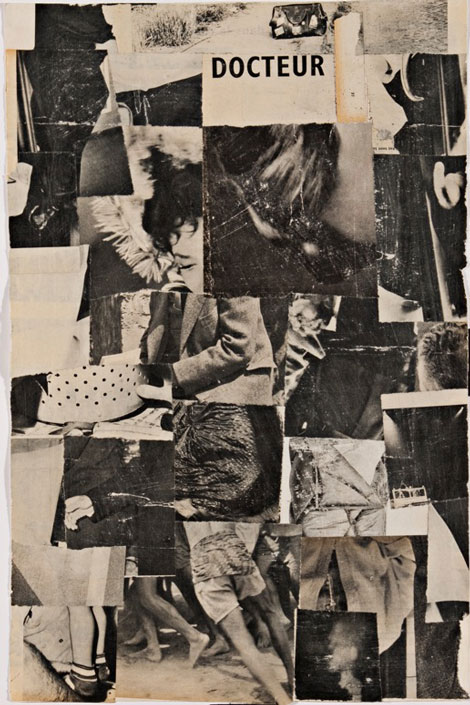
Matthew Rose, Le Docteur, (Suicide Special), 2013. Photo: Victor Matussiere / Paris (http://victormatussiere.com)
Matthew Rose’s collages do not point me at Hannah Höch’s machine world, nor at the organic world, but rather, towards the full nothingness that I have discovered in cyberspace. It is neither surprising nor coincidental that Rose has picked up on epistemological changes in art and art theory that follow connectionist developments inherent in hyper-media.
It is a well worn cliché by now that we live in the era of information overload.
Rose’s perspective on, and use of, the vast pool of connected-yet-unconnected free-floating pop images around him, allows him to question the legitimacy of commonly held beliefs and the forgone conclusions established concerning the theoretical issues of sexual politics, multiculturalism, gender studies, and the far-reaching heterogeneous philosophical critique of the cultural mechanisms of representation which have preceded it. Familiarity may not always breed contempt, exactly; but it does tend to inspire complacency. We are tempted to overlook, to take for granted, what has become blatantly familiar, no matter how odd it is in itself. We may look and register the presence of something without really seeing or understanding it. Isn’t that a basic working premise of pop collage?
It is clear that for Matthew Rose, like Höch, collage is still synonymous with some imperative promise of liberation: not only aesthetic liberation, but social, political, and even, it seems, what I might call metaphysical liberation. But what about Rose and pop collage as an enchanted form of psychoanalysis? No. What about Rose and pop transference situated, not on an analyst’s couch, but within the imitative gestations of collage? No. No. What about Rose and the noisy yet dreamy flow of pop images conjured up by the global enthusiasm for digital communications and their visual free floating signifiers that circulate by interface? Yes.
The personal computer has created for us all an affinity with fragmented visual and textual vignettes linked by nothing and everything. Rose, has picked up on this nomadic attention and, by scanning and plucking from the spread of visual representation around us, takes advantage of today’s virtual image saturation; a saturation so dense that it fails to communicate anything particular at all (except perhaps it’s overall incomprehensible sense of ripe delirium) as the reproduction system pulses with higher and higher, faster and faster flows of representational images to the point of near hysteria. Networked computers offer collage the promise of a near mythical future in which anything and everything will be immediately available to touch anything and everything else.
Specifically, in Rose’s small format collage on paper series Suicide Specials (2013), he seems to offer me an appropriately decadent regard on our social media environment. This collage series, for me, embodies the arbitrary nature of all signs grouped with other signs. Here he subverts the socially controlled systems of meanings, and so, offers me the opportunity for the creation of applicable anti-social signs (absurd anti-signs) which may continue to mentally move and multiply. Thus his Suicide Specials provides a fundamental antithesis to the authoritarian, mechanical, simulated rigidities of the controlling technical world. My experience of them, as a group, has an almost transcendental dimension. They appear to me ritualistic. I would suggest that perhaps beneath the collaged established signs that Rose selects and makes touch each other, another deeper discourse is at work which recalls a time of sacrificial phenomena.
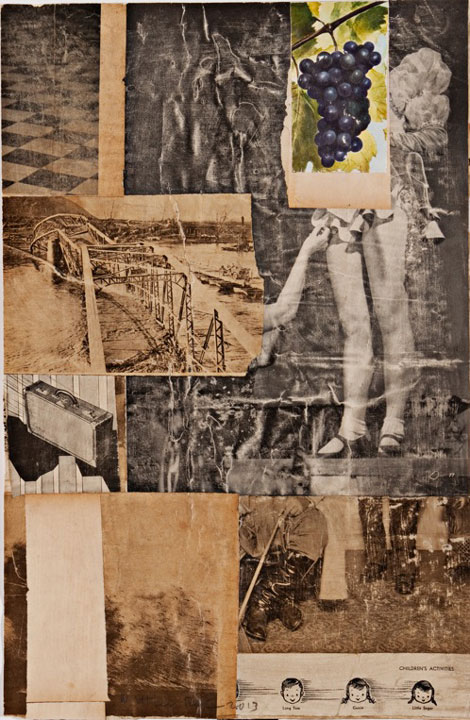
Matthew Rose, The Measurement (Suicide Special), 2013. Photo: Victor Matussiere / Paris (http://victormatussiere.com)
Suicide Specials seems, to me, structurally located as an activity that abstracts from a material order an aesthetically disembodied spirituality. It lifts the spiritual from institutional authority to individual disposability. This happens beneath the interplay of their precisely delineated distinctions. Rose brings sacrificial similitude to the sign that ultimately erases assigned singularity. His series title Suicide Specials suggests as much, and to me, it seems clear that he invested the life or death of human imagination in the outcome. Suicide Specials evokes body and void, corporality as simulation – meaning Suicide Specials has signs of withdrawal from the direct circumstances of their original presentation and portrayal. This paradox accounts for much of the naked potency of his art.
The Suicide Specials series is elaborate, heady, intricately composed, grotesque and artificial. It makes the familiar world of the simulation seem chaotic; annihilating the rejected, the external, the given, in our minds with Nietzschean slyness. It is an art of circulating forms that represents the de-centered ideological space inherent in the postmodern sensibility. These hybrid and perplexing sacrificial compositions open up a territory of arcane spiritual signification and de-territorialized meanings. They act as ciphers of the harrowed mind.
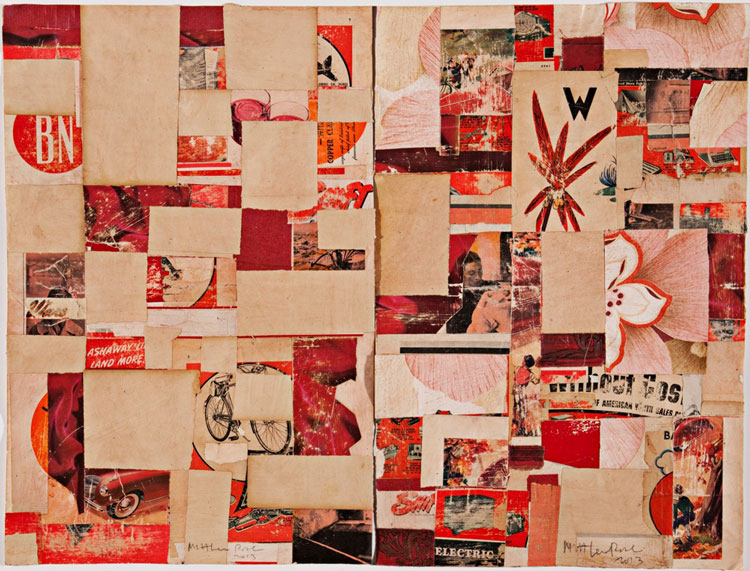
Matthew Rose, Ashaway (Suicide Special), 2013. Photo: Victor Matussiere / Paris (http://victormatussiere.com)
The collages suggest the ritual potential of social re-configuration that subsumes our previous world of simulation/representation into a nexus of touching-linked observations of the outer world with extractions of deep human mentality. This is what I appreciate most about the collages of Matthew Rose in our time of a widespread surveillance, our sense of staleness, futility and artistic disenchantment. They have an almost romantic reference to a deep time; a shadow life of nonverbal existence that moves me internally, beyond my own place and situation, and allows me the possibilities of fresh insight into art and life. I can imagine his art as a place of asylum. Or it is a place of metaphysical solidarity with everything. It is a world of glue and seduction.
Suicide Specials collages have misleading existential claims as their sentential surrogates (or general proposals which lack specificity) and therefore remain only sentential. Rose consciously exploits unfulfilled expectations by elaborating existing representational tradition to the point of apparent dissolution. As a model of conversion, Rose visualizes change with his employing of existing convention on one hand, and it’s negation of them on the other; denying normal grounds of interpretation and reception.
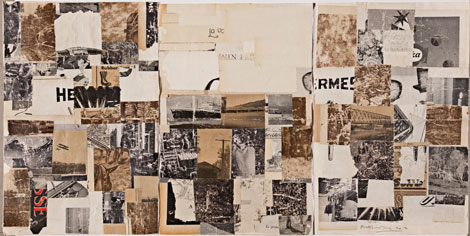
Matthew Rose, Hermes (Suicide Special), 2013. Photo: Victor Matussiere / Paris (http://victormatussiere.com)
With the Suicide Specials collages, I see a groundless surface as the dominant image. They have become terminally polluted with the collapse of once fundamental distinctions, the collapse of meaning (and the subject) through over circulation, and loss of meaningful context. Depth in such a surface-based art as collage, survives and becomes condensed and enfolded behind and beside the flat picture plane, granting me an aesthetic experience vertical in nature.
If what I have said sounds metaphysical, it is metaphysical only in so far as it is memory, intensity, and stratosphere all working together in making up an internal model of the self.
As we know, a sacrifice is for expressing thankfulness or atonement.
In our era of frenzied late-capitalist circulation of signs, Rose’s Suicide Specials create for me an almost erotic transference of voluptuous reverence that takes place beyond the point of consumption. These are spoiled images.
His symbolically spoiled and sacrificial collaged images cuts up the corporal in a private ceremony that glues delight to the grave. So, for me, there is an intimate psychic elevation here by means of the sensual. There is an invocation to the life force here, codified through the physical actions of cutting and pasting. These cuts and pastes symbolize an often cryptic and fugitive strength that is fundamentally reflective of what I widely understand as sprit. This dual commitment to corporality and abstraction is what gives the work its prestige.
In the Suicide Specials, Rose mixes and weaves composition into a rich mix of contending elements, the order and significance of which can be recovered only through an effort at comprehension. The works are embodiments of texts (in the Barth sense). They call upon me to interpret the various elements of the composition, reading the chaotic and conflicting details. Although I can almost draw their parts into a coherent whole, they still retain a provocative discord or irritation; tantalizing me towards something (a meaning, a resolution) withheld in the work.
The work’s cuts and pastes theorizes principles of linkages, of connectivity, and the intersection of everything; giving rise to theoretical production and creativity. Quite the opposite of making me consider suicide, these assemblages of appropriation suggest an almost decipherable meaning that transforms their pop form in favor of a higher psychologically and spiritually grounded subtext. My mind is stimulated to aspire to a unity of ideas that is only implied in the work of art. Only by penetrating the significance of the various details, does the organization of the compositions make some sense to me.
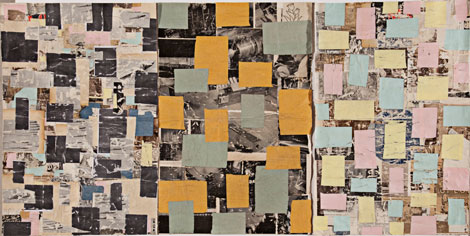
Matthew Rose, Understanding Language (Suicide Special), 2013. Photo: Victor Matussiere / Paris (http://victormatussiere.com)
Rose’s Suicide Specials are a rejection of the contemporary world and it’s values. Perhaps that is suicidal. But it represents, to me, a thrusting beyond all existing boundaries.
The Suicide Specials are complex and asymmetrical, mirroring my own fleeting impressions that constitute the movement of my consciousness, the perpetual weaving and unweaving of myself. My own cuts and pastes.
Additionally, his work captures the complexity and turbulence of our age, as it is not a reductive concept or practice, but a diagnostic one. His is the revelation of a higher order hidden in the overexposed pop image.
Rose’s Suicide Specials emphasize for me joy, death, tantalization and provocation. They seem to dwell upon the joyful pain and longing that is symptomatic of our time where no state is permanent. All is open to rearrangement in a society where there is no distance between categories of images any longer. Rose’s Suicide Specials emphasize this outlook while forcing on me an intellectual re-creation of form in my mind. Indeed, to my eye, within the borders of his collaged spectacle, Rose’s tottering and circuitous fabrications automatically hasten my own elaborate visual irrationality. Consequently, Rose’s collages lead me to a teeming process of rational expurgation through visual excess. They lead me to scenes of elation mixed with tremendous dread, and can, at times, be ethically evasive, as they seem more concerned with the unfathomable, the sublimity of pessimism, the disappointment of failed rationality, the horror of a bottomless human nature, and the wonderful terror of the empty fullness around us.
See Matthew Rose’s work currently up now:
Converge Gallery
July 11th – August 2nd
140 West 4th Street
Williamsport, PA
Metamorphic | Curated by Kasey Lyon
www.convergegallery.com

